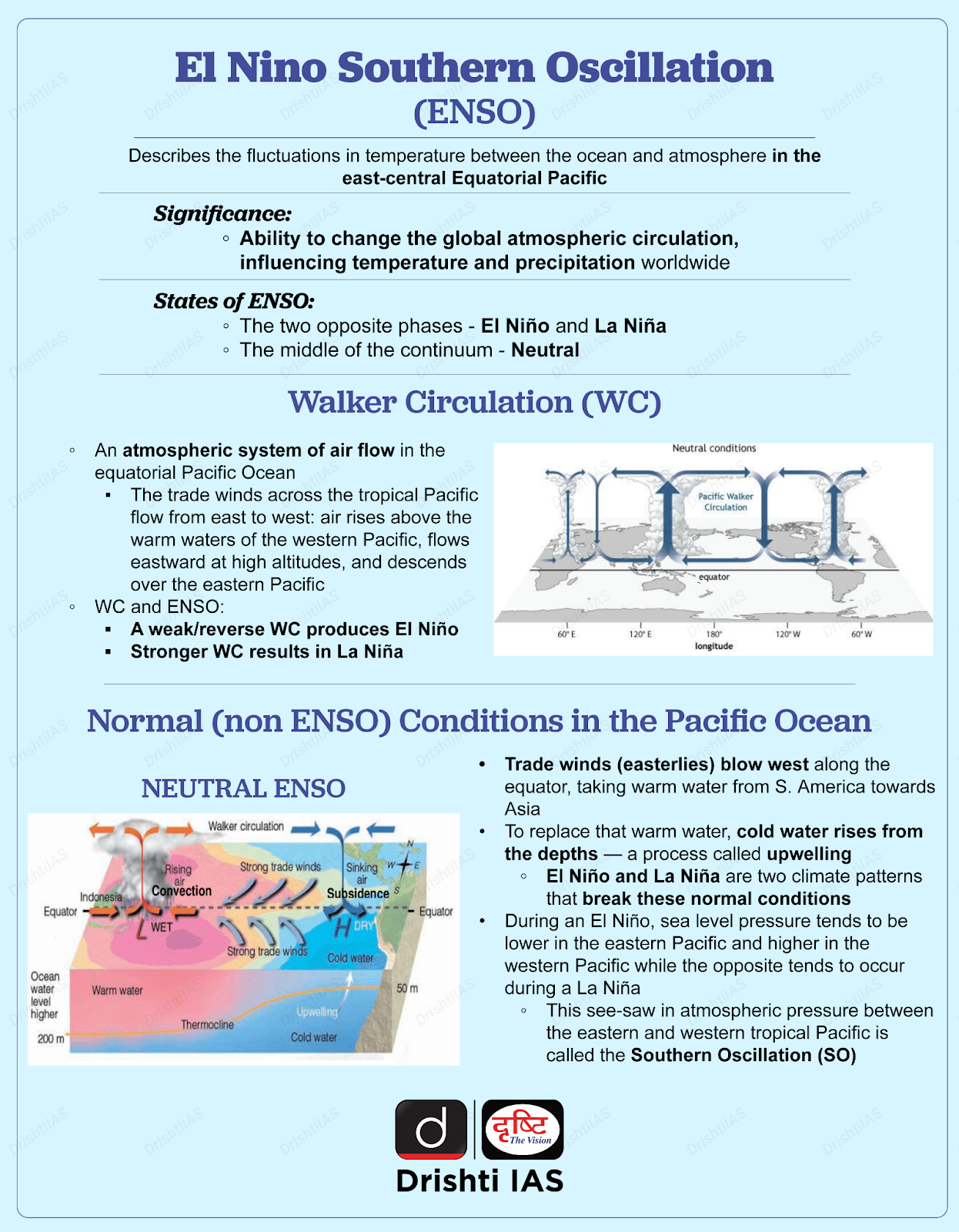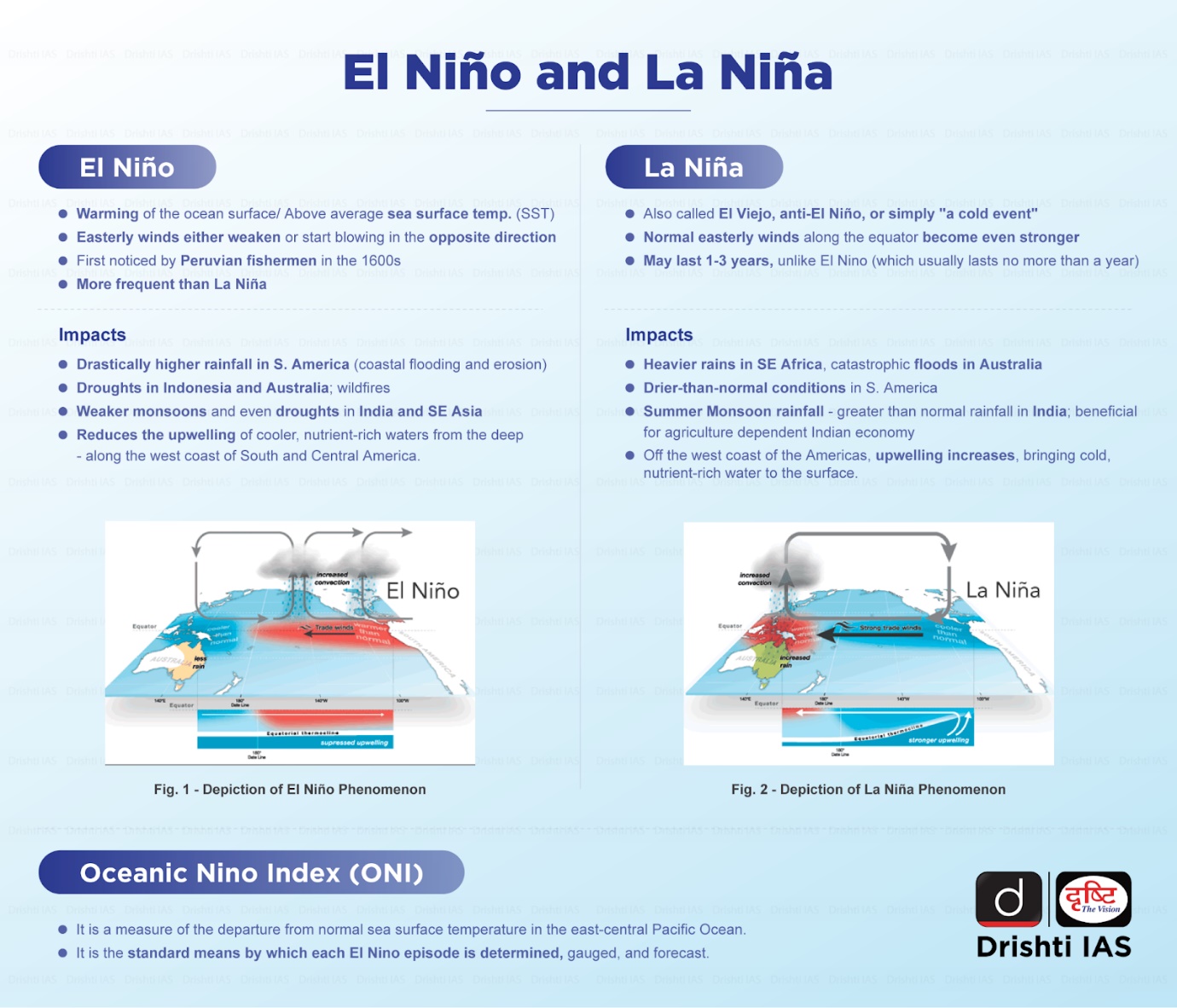Geography
El Nino 2023: Unusual Warming Like 2009
- 09 Jun 2023
- 6 min read
For Prelims: El Nino, La Nina, El Nino-Southern Oscillation
For Mains: EL Nino and its impacts, Relationship between El Nino and global warming
Why in News?
Recently, an unusual phenomenon is developing along the equatorial Pacific region, indicating the emergence of El Nino conditions in 2023. Experts warn that this simultaneous warming of the eastern and western regions of the equatorial Pacific, a trend last observed in 2009, could have severe implications for marine life worldwide.
What are the Causes for this Phenomenon?
- The eastern Pacific is getting warmer, which should make the west cooler.
- However, due to global warming, there is basin scale warming across the tropical Pacific.
- Two things could have triggered this phenomenon:
- Global warming in the Pacific and other modes of natural variability
- The transition from La Nina winter into an El Nino summer which is part of the El Nino-Southern Oscillation (ENSO) cycle.
- Basin Scale Warming in the Equatorial Pacific:
- Due to global warming, the equatorial Pacific experiences basin scale warming, causing both eastern and western regions to become warmer.
- The measurement of basin scale refers to the spatial extent of a basin or common water outlet, in this case, the equatorial Pacific region.
- Recent data analysis shows that the ocean temperatures on May 29, 2023, were unusually warm compared to the 2003-2014 average.
What is ENSO?
What are the Potential Consequences of this Phenomenon?
- Global Warming:
- The end of La Nina means that the ocean is not taking up heat, which will dissipate into the atmosphere.
- If the atmosphere is warmer, then the ocean doesn't lose as much heat, causing it to warm up at the surface.
- This may temporarily push global warming beyond 1.5°C.
- The end of La Nina means that the ocean is not taking up heat, which will dissipate into the atmosphere.
- Geophysical Effect:
- The phenomenon will affect cyclones, hurricanes, and typhoons, with Typhoon Mawar in the western Pacific already being one of the strongest.
- The warming of ocean waters acts as a catalyst for marine heatwaves, the slowing of meridional circulation, which could cause unmitigable losses for marine biodiversity.
- Coral Bleaching:
- A warming of 1.5°C threatens to destroy 70 to 90 per cent of coral reefs, and a 2°C increase means a nearly 100 per cent loss – a point of no return.
Previous El Nino Events:
- El Nino events of 1982-83 and 1997-98 were the most intense of the 20th century.
- During the 1982-83 event, sea surface temperatures in the eastern tropical Pacific were 9-18° F above normal.
- The El Nino event of 1997-98 was the first El Nino event to be scientifically monitored from beginning to end.
- The 1997-98 event produced drought conditions in Indonesia, Malaysia, and the Philippines. Peru and California experienced very heavy rains and severe flooding.
- The Midwest experienced record-breaking warm temperatures during a period known as “the year without a winter.”
- The El Nino, along with global warming, had made 2016 the warmest year on record.
What is the Impact El Nino 2023 on India?
- Weak Monsoon for India: The development of an El Nino in May or June 2023 may cause weakening of the southwest monsoon season, which brings around 70% of the total rainfall India receives and on which most of its farmers still depend.
- However, sub-seasonal factors such as the Madden-Julian Oscillation (MJO) and monsoon low-pressure systems can temporarily enhance rainfall in some parts as witnessed in the year 2015.
- Hot Temperatures: It may also cause heatwaves and droughts in India and other regions around the world such as South Africa, Australia, Indonesia and the Pacific Islands.
UPSC Civil Services Examination, Previous Year Question (PYQ)
Prelims
Q. With reference to ‘Indian Ocean Dipole (IOD)’ sometimes mentioned in the news while forecasting Indian monsoon, which of the following statements is/are correct? (2017)
- IOD phenomenon is characterised by a difference in sea surface temperature between tropical Western Indian Ocean and tropical Eastern Pacific Ocean.
- An IOD phenomenon can influence an El Nino’s impact on the monsoon.
Select the correct answer using the code given below:
(a) 1 only
(b) 2 only
(c) Both 1 and 2
(d) Neither 1 nor 2
Ans: (b)
Mains
Q. Most of the unusual climatic happenings are explained as an outcome of the El-Nino effect. Do you agree? (2014)








